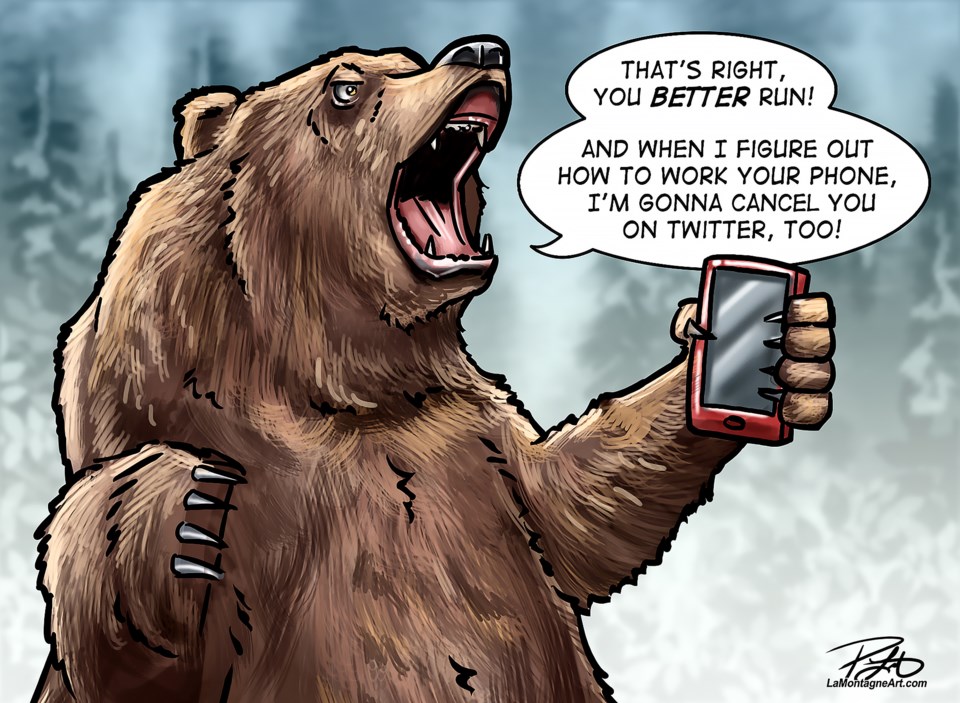The bears are out and about.
It’s hard to go more than a few days without seeing a black bear or grizzly bear or seeing a new closure that is limiting people from going to an area of the Bow Valley to avoid potential human-wildlife conflict.
While it’s a special moment to see a grizzly bear – and the more common black bear – it also comes with a responsibility of an individual or people to respect the bear's need for space and not to linger.
Though majestic animals, bears can feel easily threatened by people who get too close, dawdle in one area too long and are none too kind if they’re hungry and feel someone’s on their territory. Several bluff charges have already been reported and more will come before the end of the busy summer season.
The influx of more vehicle traffic can also lead to more deadly encounters.
In June, three grizzly bears have been killed on the busy roads of the Canadian Rocky Mountains.
A female grizzly was killed June 16 – with an orphaned cub now on its own – in Jasper National Park and a male grizzly was killed on the Trans-Canada Highway in Yoho National Park on June 11. That death came only four days after a five-year-old female grizzly bear was also killed in on the same stretch of highway.
Parks Canada quickly started a no-stop zone and brought the speed limit down to 70 km/h between Sherbrooke Creek and Yoho Valley Road on Field Hill after the death of the female grizzly on June 7. The speed limit was dropped further to 50 km/h after the male bear was killed.
The RCMP and park wardens have also been busy handing out more than 100 speeding tickets in the zone and a handful for those pulling over in the no-stopping zone.
An adult grizzly was struck and killed by a train west of Lake Louise on the Canadian Pacific Railway on May 12 and a black bear was killed on the Trans-Canada Highway west of Field June 13.
The deaths of those bears – particularly the grizzlies that are listed as threatened species in Alberta – are felt throughout the region.
The grizzly bear hunt in Alberta was only halted in 2006 as numbers had been drastically impacted. In the past 16 years, the population has slowly rebounded but growing development in the valley has impacted animal movement and each year those vehicle or train collisions lead to more being killed.
This spring has brought far more bears into the residential areas than in the past.
Wildlife and climate experts have said the late arrival of spring and the snowpack lingering in the mountains have kept food-driven bears in the lower elevations of the valley as they feast on dandelions much longer than typical years.
Anyone trekking down the vehicle-closed part of the Bow Valley Parkway in Banff National Park has likely seen countless bears, while Kananaskis Country has been flush with closures after people encounter bears.
Parks Canada, Alberta Parks, CPAWS Southern Alberta and countless others all offer useful advice that all locals should know and visitors should take time to learn.
Checking for trail closures, knowing how to use bear spray and keeping a dog on a leash are all important.
Since the municipal election, the relaunch of the Bow Valley human-wildlife coexistence roundtable has led to more discussion between municipalities and the province.
The towns of Banff and Canmore also work together on clever advertising campaigns to help inform and educate visitors and residents alike.
However, the province is now without a human-wildlife biologist and fish and wildlife officers are spread out over enormous swaths of territory with few resources.
All levels of government also have to make it a priority to work with one another, but also give adequate resources to lessen the risk of human-wildlife conflicts.
However, to successfully mitigate human-wildlife conflicts, each person has to take responsibility for their actions.




